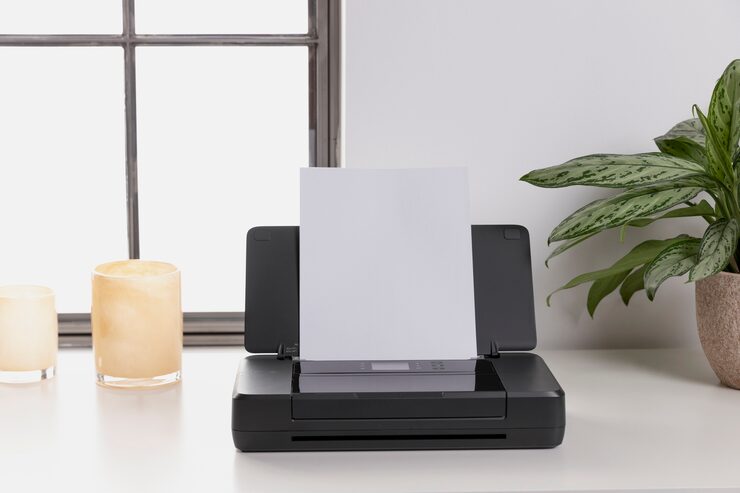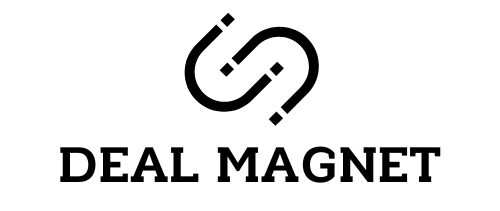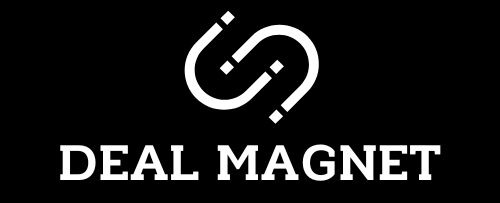“Dealmagnet.uk is a participant in the Amazon EU Associates Programme, an affiliate advertising programme designed to provide a means for sites to earn advertising fees by advertising and linking to Amazon.co.uk.”
An A4 laminator is a must-have tool for offices, schools, home businesses, and creative projects. From preserving important documents to crafting photo projects or protecting kids’ artwork, laminators add durability and a polished finish.
But with so many models available—ranging from compact home laminators to heavy-duty office machines—choosing the right one can be overwhelming. This guide will walk you through everything you need to know before buying an A4 laminator, including types, key features, pros and cons, and who each style is best suited for.

What to Consider Before Buying an A4 Laminator
When shopping for a laminator, keep these points in mind:
- Laminating Speed – Faster speed saves time if you laminate frequently.
- Warm-Up Time – Shorter warm-up times mean less waiting.
- Pouch Thickness Compatibility – Check if it supports different film thicknesses (e.g., 80–250 microns).
- Size & Portability – Compact designs suit home use, while larger models fit office needs.
- Temperature Control – Adjustable settings improve quality for different materials.
- Anti-Jam System – Essential for smooth operation and avoiding damaged documents.
- Usage Frequency – Choose a heavy-duty model for daily use, or a light one for occasional projects.
Product Summary: Types of A4 Laminators
Here’s an overview of the main types you’ll find:
1. Hot Laminators
- Use heated rollers to melt adhesive on laminating pouches.
- Best For: Offices, schools, and projects requiring durable protection.
- Key Features: Smooth finish, strong seal.
2. Cold Laminators
- Use pressure instead of heat, suitable for heat-sensitive materials.
- Best For: Photos, inkjet prints, or craft projects.
- Key Features: Safe for kids, no warm-up needed.
3. Portable Laminators
- Compact and lightweight, often USB-powered.
- Best For: Home users, teachers, and small craft projects.
- Key Features: Easy to carry, affordable.
4. Heavy-Duty Laminators
- Built for large volumes and frequent use.
- Best For: Offices, businesses, and schools with daily laminating needs.
- Key Features: Faster speed, multiple thickness settings, jam prevention.
Pros & Cons of A4 Laminators
| Type | Pros | Cons |
|---|---|---|
| Hot Laminator | Strong seal, professional look, durable finish | Needs warm-up time, not for heat-sensitive items |
| Cold Laminator | Safe for photos, instant use, no electricity needed | Not as durable as hot lamination |
| Portable Laminator | Compact, lightweight, easy for home or travel use | Slower speed, limited thickness support |
| Heavy-Duty Model | Handles large volumes, faster, versatile | Higher price, bulkier size |
Who It’s Best For
- Students & Teachers – Portable or hot laminators for study notes, flashcards, and school projects.
- Office Professionals – Heavy-duty laminators for ID cards, presentations, and contracts.
- Crafters & Hobbyists – Cold laminators for scrapbooks, photos, and artwork.
- Home Users – Compact laminators for recipes, kids’ artwork, and documents.
FAQs About A4 Laminators
Q1: What pouch thickness should I choose?
- Light use: 80–100 microns.
- Moderate use: 125 microns.
- Heavy-duty protection: 150–250 microns.
Q2: Do laminators require maintenance?
Yes. Clean rollers occasionally and avoid leaving unused pouches inside.
Q3: Can I laminate photos?
Yes, but use a cold laminator or ensure your hot laminator has settings for photos to avoid damage.
Q4: How long does lamination last?
Properly laminated documents can last for years without yellowing or peeling.
Q5: Are laminators safe for kids?
Cold laminators are safest since they don’t use heat.
Buying Tips from Experience
Based on research and user insights:
- If you laminate occasionally, a compact hot laminator with quick warm-up is ideal.
- If you laminate frequently, a heavy-duty machine saves time and effort.
- If you work with sensitive materials, stick to cold lamination.
- Always check if the machine includes jam release functions—they prevent frustration and wasted supplies.
Final Recommendation
An A4 laminator can be a versatile tool whether you’re preserving documents, creating crafts, or preparing professional presentations.
- Choose a hot laminator for strong, long-lasting results.
- Opt for a cold laminator if you’re dealing with heat-sensitive materials.
- Pick a portable option if space-saving and convenience are priorities.
- Invest in a heavy-duty model if your workload demands frequent, high-volume use.
The key is to balance your needs, budget, and usage frequency. By considering factors like speed, size, pouch compatibility, and safety features, you’ll find a laminator that delivers reliability and efficiency.eryday life.
What to Consider Before Buying an EV Charger Cable
Before purchasing, think about these important factors:
1. Compatibility with Your EV
- Not all EVs use the same plug type.
- In Europe and many other regions, Type 2 plugs are standard for AC charging.
- The 3-pin plug makes it possible to charge directly from a standard household socket.
2. Power Rating (kW)
- This guide focuses on 2.99 kW, which is suitable for slow, overnight charging.
- It’s safe for home use but slower compared to dedicated wall chargers.
3. Adjustable Amperage (6A/8A/10A/13A)
- Adjustable current settings give flexibility.
- Lower amperage = slower charging but less strain on household wiring.
- Higher amperage = faster charging but requires safe and stable wiring.
4. Cable Length
- A 6-meter cable strikes a balance between convenience and manageability.
- Long enough to reach your car in most driveway or garage setups.
5. Safety Features
- Look for cables with over-current, over-voltage, and temperature protection.
- Waterproofing and durable insulation are essential for outdoor use.
6. Portability
- Since these cables can plug into a standard outlet, they’re highly portable.
- Great for charging on trips where charging stations may not be available.
Product Summary: EV Charger Cable (Type 2 to 3-Pin Plug)
Here’s a breakdown of the cable type we’re discussing:
| Feature | Details |
|---|---|
| Connector Type | Type 2 (car side) to 3-Pin Plug (household socket) |
| Power Output | 2.99 kW (slow charging) |
| Adjustable Current | 6A, 8A, 10A, 13A |
| Cable Length | 6 meters |
| Charging Method | AC charging via domestic socket |
| Ideal Use | Overnight charging at home, backup charging during travel |
Pros & Cons
Pros
- ✅ Compatible with most Type 2 EVs.
- ✅ Can be used with a standard household socket (no special installation).
- ✅ Adjustable current settings give flexibility and safety.
- ✅ Portable and travel-friendly.
- ✅ Affordable entry point compared to wall-mounted chargers.
Cons
- ❌ Slower charging compared to wall boxes or public fast chargers.
- ❌ Long charging times may not suit drivers with high daily mileage.
- ❌ Relies on household sockets, which may not be ideal for continuous use at higher amperage.
- ❌ Not weatherproof unless specified (important for outdoor charging).
Who It’s Best For
This type of EV charger cable is best suited for:
- New EV Owners – Perfect for those just starting their EV journey and don’t want to invest in a dedicated wall box yet.
- Urban Drivers – If you have short daily commutes, overnight charging at 2.99 kW is more than enough.
- Travelers – Great backup cable when charging stations aren’t available.
- Budget-Conscious Users – Cheaper than professional installation of charging stations.
- Apartment Dwellers – Useful if you only have access to household sockets.
Comparing EV Charging Options
| Charging Option | Power Output | Time for Full Charge | Best For |
|---|---|---|---|
| Standard Household Plug (3-pin) | ~2.99 kW | 10–20 hours (depending on battery size) | Overnight charging |
| Dedicated Wall Charger (Type 2) | 7–22 kW | 3–8 hours | Faster home charging |
| Public AC Charger | 11–22 kW | 2–6 hours | Public places, offices |
| Public DC Fast Charger | 50–350 kW | 30 min – 2 hours | Long-distance travel |
Real-World Use Cases
- Case 1: Daily Commuter
Sarah drives 30 km a day. With overnight charging using a 2.99 kW Type 2 to 3-pin cable, her EV battery is fully recharged each night, making it the perfect low-cost option. - Case 2: Traveler
Mark often takes road trips. He keeps a 6m portable cable in his trunk, ensuring he can always charge from a regular socket at hotels or guest houses. - Case 3: Budget Buyer
Emma didn’t want to spend extra on a wall box. The adjustable 6/8/10/13A settings let her manage charging safely at home without upgrading her electrical system.
FAQs About EV Charger Cables
Q1: How long does it take to charge with a 2.99 kW cable?
It depends on your EV’s battery size. For example, a 40 kWh battery might take around 13–15 hours for a full charge.
Q2: Can I leave the cable plugged in overnight?
Yes, but ensure your socket and wiring are in good condition. Many cables come with safety cut-off features.
Q3: Is a wall box better than this cable?
Yes for speed, but no if you only need overnight charging and want a portable, low-cost solution.
Q4: Are 3-pin plug chargers safe?
Yes, if used correctly. Always check for over-current protection and waterproof ratings if used outdoors.
Q5: Do I need a longer cable than 6 meters?
For most home setups, 6m is sufficient. However, if your parking spot is far from the outlet, consider a longer cable.
Final Recommendation
A Type 2 to 3-pin plug EV charger cable with 2.99 kW output, 6 meters in length, and adjustable 6/8/10/13A settings is an excellent choice for EV owners who:
- Want an affordable charging option.
- Need overnight charging at home.
- Travel often and require a portable solution.
While it’s not the fastest charging method, it’s practical, safe, and convenient for most everyday EV users. For higher mileage drivers, upgrading to a dedicated wall charger is recommended—but as a backup or starter solution, this cable is hard to beat.
Conclusion
Choosing the right EV charging cable ensures safe, efficient, and hassle-free charging for your electric vehicle. A Type 2 to 3-pin plug charger cable is particularly useful for those who need flexibility, portability, and affordability.
By considering key factors like compatibility, power rating, adjustable amperage, safety features, and length, you can confidently select a cable that meets your needs.
In the evolving world of electric mobility, investing in a reliable charging solution is not just about convenience—it’s about ensuring your EV ownership experience is smooth and stress-free.
With this buying guide, you’re now ready to make an informed decision and choose a cable that fits your lifestyle.
Latest Posts
- Breathe Easy: Your Complete Dehumidifier Buying GuideAROEVE Dehumidifier 1000ml, Dehumidifiers for Home, Auto Off, Auto Defrost, Peltier Technology, Coloured Light, Portable, Quiet, for Wardrobe, Bedroom, Bathroom “Dealmagnet.uk is a participant in the Amazon EU Associates Programme, an affiliate advertising programme designed to provide a means for sites to earn advertising fees by advertising and linking to Amazon.co.uk.” Humidity may be invisible,… Read more: Breathe Easy: Your Complete Dehumidifier Buying Guide
- Freedom to Clean: Your Ultimate Cordless Vacuum Buying GuideCordless Vacuum Cleaner,Stick Vacuum 45KPA/450W/60min,Wall-mounted Charging/V-shaped Anti-Tangle,with Self-standing Function and Removable Battery,Vacuum Cleaner for Pet Hair,Carpets and Hard Floors Ultenic T10 Lite Robot Vacuum Cleaner with Mop 5000Pa, 15min Lidar Quick Mapping, Self Charging & Emptying, Allergy Friendly, Carpet Auto-boost,Siri/Alexa/APP Remote Control Hoover for Floors Pet Hair Cordless Vacuum Cleaner 48KPa/550W/65min,Stick Vacuum Cleaner with Anti-Tangle… Read more: Freedom to Clean: Your Ultimate Cordless Vacuum Buying Guide
- Smart Choice: The Ultimate Smart Tablet Buying GuideDOOGEE TAB A9+ 2025 Newest 11 Inch Android 15 Tablet, 8580mAh Tablet With Keyboard, T7200 Octa Core Android Tablets, 20GB + 64GB/2TB Tablets With Pen, 13+5MP, 2 Speakers + Widevine L1, Mouse & Case DOOGEE U11 PRO Android Tablets, 30GB RAM + 256GB ROM/2TB, Unisoc T7200 Octa-Core 11 Inch Tablet, 8580mAh Large Battery, 90Hz IPS… Read more: Smart Choice: The Ultimate Smart Tablet Buying Guide
- Data on Demand: The Ultimate Hard Drive Buying Guide
 Aiolo Innovation 500GB Ultra Slim Portable External Hard Drive HDD-USB 3.0 for PC, Mac, Laptop, PS4, Xbox one,Xbox 363-Super Fast Transmission “Dealmagnet.uk is a participant in the Amazon EU Associates Programme, an affiliate advertising programme designed to provide a means for sites to earn advertising fees by advertising and linking to Amazon.co.uk.” In today’s digital… Read more: Data on Demand: The Ultimate Hard Drive Buying Guide
Aiolo Innovation 500GB Ultra Slim Portable External Hard Drive HDD-USB 3.0 for PC, Mac, Laptop, PS4, Xbox one,Xbox 363-Super Fast Transmission “Dealmagnet.uk is a participant in the Amazon EU Associates Programme, an affiliate advertising programme designed to provide a means for sites to earn advertising fees by advertising and linking to Amazon.co.uk.” In today’s digital… Read more: Data on Demand: The Ultimate Hard Drive Buying Guide - Power Up Smartly: Ultimate Charger & Battery Buying Guide
 Battery Charger Compatible with Dewalt 12V/20V Battery, 2-Ports Fast Charger Compatible with Dewalt DCB 203 204 205 206 201 120 127 Lithium Battery “Dealmagnet.uk is a participant in the Amazon EU Associates Programme, an affiliate advertising programme designed to provide a means for sites to earn advertising fees by advertising and linking to Amazon.co.uk.” From… Read more: Power Up Smartly: Ultimate Charger & Battery Buying Guide
Battery Charger Compatible with Dewalt 12V/20V Battery, 2-Ports Fast Charger Compatible with Dewalt DCB 203 204 205 206 201 120 127 Lithium Battery “Dealmagnet.uk is a participant in the Amazon EU Associates Programme, an affiliate advertising programme designed to provide a means for sites to earn advertising fees by advertising and linking to Amazon.co.uk.” From… Read more: Power Up Smartly: Ultimate Charger & Battery Buying Guide - Perfect Finish Every Time: Ultimate Paint Sprayer Buying Guide
 YIREAL Fence Paint Sprayer 800W,Electric Spray Paint Gun with 1300ml Container 3 Meters Cable 1.8M Hose,HVLP Spray Gun with 3 Nozzles 3 Spray Modes for Walls Ceilings Sheds Furniture House Painting “Dealmagnet.uk is a participant in the Amazon EU Associates Programme, an affiliate advertising programme designed to provide a means for sites to earn advertising… Read more: Perfect Finish Every Time: Ultimate Paint Sprayer Buying Guide
YIREAL Fence Paint Sprayer 800W,Electric Spray Paint Gun with 1300ml Container 3 Meters Cable 1.8M Hose,HVLP Spray Gun with 3 Nozzles 3 Spray Modes for Walls Ceilings Sheds Furniture House Painting “Dealmagnet.uk is a participant in the Amazon EU Associates Programme, an affiliate advertising programme designed to provide a means for sites to earn advertising… Read more: Perfect Finish Every Time: Ultimate Paint Sprayer Buying Guide - Sound Without Strings: Buying Guide for Wireless Earbuds & Earphones
 Niderson Wireless Earbuds, Headphones with Screen Stereo Bass, 48Hrs Playtime, Red Niderson Wireless Earbuds, Headphones with Screen Stereo Bass, 48Hrs Playtime, Grey Niderson Open Ear Wireless Earbuds Bluetooth Headphones, Grey Ear Buds for Fitness/Workouts/Travel “Dealmagnet.uk is a participant in the Amazon EU Associates Programme, an affiliate advertising programme designed to provide a means for sites… Read more: Sound Without Strings: Buying Guide for Wireless Earbuds & Earphones
Niderson Wireless Earbuds, Headphones with Screen Stereo Bass, 48Hrs Playtime, Red Niderson Wireless Earbuds, Headphones with Screen Stereo Bass, 48Hrs Playtime, Grey Niderson Open Ear Wireless Earbuds Bluetooth Headphones, Grey Ear Buds for Fitness/Workouts/Travel “Dealmagnet.uk is a participant in the Amazon EU Associates Programme, an affiliate advertising programme designed to provide a means for sites… Read more: Sound Without Strings: Buying Guide for Wireless Earbuds & Earphones - Smart Connections:Buying Guide for Adapters & Extensions
 AUNNO Double Shaver Plug Adaptor UK, 2500W 2 Way Plug Adapter for Bathroom Electric Razor and Electric Toothbrush etc, 2 Pin to 3 Pin Plug Adapter with 10A Fuse AUNNO Pack of 2 UK to European Plug Adapter, UK 3 Pin to European 2 Pin Plug Converter, Euro Type C, E, F and Type G,… Read more: Smart Connections:Buying Guide for Adapters & Extensions
AUNNO Double Shaver Plug Adaptor UK, 2500W 2 Way Plug Adapter for Bathroom Electric Razor and Electric Toothbrush etc, 2 Pin to 3 Pin Plug Adapter with 10A Fuse AUNNO Pack of 2 UK to European Plug Adapter, UK 3 Pin to European 2 Pin Plug Converter, Euro Type C, E, F and Type G,… Read more: Smart Connections:Buying Guide for Adapters & Extensions - Clean Smarter: The Ultimate Vacuum Cleaner Buying Guide
 Ultenic U15 Cordless Vacuum Cleaner 50000Pa/65Min Runtime, Anti-tangle Brush with GreenEye Technology, Self Standing Stick Vacuum, Telescopic Tube, Ideal for All Floors, Carpet & Pet Hair “Dealmagnet.uk is a participant in the Amazon EU Associates Programme, an affiliate advertising programme designed to provide a means for sites to earn advertising fees by advertising and linking… Read more: Clean Smarter: The Ultimate Vacuum Cleaner Buying Guide
Ultenic U15 Cordless Vacuum Cleaner 50000Pa/65Min Runtime, Anti-tangle Brush with GreenEye Technology, Self Standing Stick Vacuum, Telescopic Tube, Ideal for All Floors, Carpet & Pet Hair “Dealmagnet.uk is a participant in the Amazon EU Associates Programme, an affiliate advertising programme designed to provide a means for sites to earn advertising fees by advertising and linking… Read more: Clean Smarter: The Ultimate Vacuum Cleaner Buying Guide - Smart Picks: The Ultimate Smartphone Buying Guide
 DOOGEE Note 56 Mobile Phones, Newest Android 16 Smartphone, 6150mAh, 8.45mm Ultra-Slim, 6.56″ HD+ 90Hz, 24GB + 64GB/2TB Android Phones, Dual SIM Unlocked Mobile Phone, Face ID, GPS, OTG, FM-White DOOGEE Fier 5 Pro Android 15 Rugged Smartphone & Gemini AI – 20GB + 128GB, 13000mAh & MTK Helio G81 Octa Core Rugged Phone,90Hz 6.6″… Read more: Smart Picks: The Ultimate Smartphone Buying Guide
DOOGEE Note 56 Mobile Phones, Newest Android 16 Smartphone, 6150mAh, 8.45mm Ultra-Slim, 6.56″ HD+ 90Hz, 24GB + 64GB/2TB Android Phones, Dual SIM Unlocked Mobile Phone, Face ID, GPS, OTG, FM-White DOOGEE Fier 5 Pro Android 15 Rugged Smartphone & Gemini AI – 20GB + 128GB, 13000mAh & MTK Helio G81 Octa Core Rugged Phone,90Hz 6.6″… Read more: Smart Picks: The Ultimate Smartphone Buying Guide - Brew It Right: Your Coffee Buying Guide
 KOFIKOFI 54mm Bottomless Portafilter, Walnut Handle 3 Ears Naked Portafilter with Puck Screen, Compatible with Sage Breville Barista Series 500-880, Barista Express, and More 54mm Models KOFIKOFI Portafilter 58mm 2 Ears, Compatible with Gaggia Classic Espresso Machines, Naked Bottomless Portafilter with Puck Screen and Filter Basket (Black) KOFIKOFI Bottomless Portafilter 58mm with Puck Screen and… Read more: Brew It Right: Your Coffee Buying Guide
KOFIKOFI 54mm Bottomless Portafilter, Walnut Handle 3 Ears Naked Portafilter with Puck Screen, Compatible with Sage Breville Barista Series 500-880, Barista Express, and More 54mm Models KOFIKOFI Portafilter 58mm 2 Ears, Compatible with Gaggia Classic Espresso Machines, Naked Bottomless Portafilter with Puck Screen and Filter Basket (Black) KOFIKOFI Bottomless Portafilter 58mm with Puck Screen and… Read more: Brew It Right: Your Coffee Buying Guide - Clean Smarter, Not Harder: The Ultimate Vacuum Cleaner Buying Guide
 Ultenic U20 Cordless Vacuum Cleaner 55KPa/60Min,Enhanced Powerful Suction, Upgraded Anti Hair Wrap Brush with Fordable Wand, LED Countdown Display, Self Standing Hoover for Floors, Carpet & Pet Hair “Dealmagnet.uk is a participant in the Amazon EU Associates Programme, an affiliate advertising programme designed to provide a means for sites to earn advertising fees by advertising… Read more: Clean Smarter, Not Harder: The Ultimate Vacuum Cleaner Buying Guide
Ultenic U20 Cordless Vacuum Cleaner 55KPa/60Min,Enhanced Powerful Suction, Upgraded Anti Hair Wrap Brush with Fordable Wand, LED Countdown Display, Self Standing Hoover for Floors, Carpet & Pet Hair “Dealmagnet.uk is a participant in the Amazon EU Associates Programme, an affiliate advertising programme designed to provide a means for sites to earn advertising fees by advertising… Read more: Clean Smarter, Not Harder: The Ultimate Vacuum Cleaner Buying Guide - Relax Deep: Buying Guide for Massage & All Chairsyewglen Massage Chair Full Body, Zero Gravity Massage Chair with 10 Fixed Rollers, Wood Grain Leather, Heating, Foot Massage, Airbags, Bluetooth and Control Screen ROTAI Full Body Massage Chair,24 Fixed Massage Nodes,Back Neck Foot Massage for Home,Zero Gravity Rocking Recliner with Heat “Dealmagnet.uk is a participant in the Amazon EU Associates Programme, an affiliate advertising… Read more: Relax Deep: Buying Guide for Massage & All Chairs
- Everyday Essentials Buying Guide: Make Smart Choices for Daily LivingZHJAN Drywall Pole Sander, 360° Rotation Radial Round Head Sander with Extension Pole & 10 PCS Sanding Sheets (100,120,150,180,240 Grit), Wall Sanding Tool for Painted Walls and Ceilings “Dealmagnet.uk is a participant in the Amazon EU Associates Programme, an affiliate advertising programme designed to provide a means for sites to earn advertising fees by advertising… Read more: Everyday Essentials Buying Guide: Make Smart Choices for Daily Living
- Warmth Products: The Ultimate Hand Warmer Buying Guide
 Space Heater with PTC Ceramic, 1200W Portable Electric Heater with Smart Remote, Thermostat, 3S Fast Heat, 2 Modes, 12H Timer, Overheat Protection, Fan Heater with LCD Display for Office Desk Bedroom FANDLISS 10000mAh Rechargeable Hand Warmers 2 pack, Double-sided Heating Electric Magnetic Handwarmers Portable Pocket-Sized Heater, for Raynauds, Hunting, Golf, Camping, Women Mens Tech Gifts,… Read more: Warmth Products: The Ultimate Hand Warmer Buying Guide
Space Heater with PTC Ceramic, 1200W Portable Electric Heater with Smart Remote, Thermostat, 3S Fast Heat, 2 Modes, 12H Timer, Overheat Protection, Fan Heater with LCD Display for Office Desk Bedroom FANDLISS 10000mAh Rechargeable Hand Warmers 2 pack, Double-sided Heating Electric Magnetic Handwarmers Portable Pocket-Sized Heater, for Raynauds, Hunting, Golf, Camping, Women Mens Tech Gifts,… Read more: Warmth Products: The Ultimate Hand Warmer Buying Guide
“Dealmagnet.uk is a participant in the Amazon EU Associates Programme, an affiliate advertising programme designed to provide a means for sites to earn advertising fees by advertising and linking to Amazon.co.uk.”





